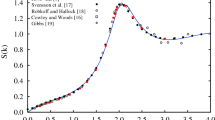Abstract
By the study of a simple example, namely the evolution in timet of an electron-phonon system with fixed, total momentum, it is shown that the “standard” treatment of “phonon drag”, which involves solving the (linearized and spatially homogeneous) coupled electron and phonon Boltzmann equations by an iteration procedure, is not always correct. In the asymptotic limit (t→∞), the iteration or “standard” procedure does not give the “correct” (i.e. the equilibrium statistical mechanical) result for the distribution of momentum between electrons and phonons. However, a proper treatment of the Boltzmann equations does lead to the “correct” sharing of momentum between electrons and phonons fort→∞. All the calculations in this paper are performed for metals at high temperatures (i.e.,T>ΘD, the Debye temperature).
Résumé
L’étude d’un exemple simple a été entreprise, à savoir, l’évolution dans le tempst d’un système électron-phonon dont l’impulsion totale ext fixe. Le traitement “standard” du “phonon drag” qui implique pour le système couplé d’électrons et de phonons une solution par itération de l’équation de Boltzmann (linéarisée et homogène dans l’espace), n’est pas toujours correct. A la limite asymptotique (t→∞) la méthode d’itération ou “standard” ne livre pas résultat “correct” (c’est-à-dire l’équilibre statistique) pour la distribution des impulsions entre électrons et phonons. Cependant un traitement approprié de l’équation de Boltzmann conduit à une répartition “correcte” des impulsions entre électrons et phonons pourt→∞. Dans cette publication tous les calculs sont effectués pour des métaux à hautes températures (c’est-à-dire,T>ΘD, température de Debye).
Zusammenfassung
An Hand eines einfachen Beispiels, bei dem man die zeitliche Änderung eines Elektron-Phonon-Systems mit festem Gesamt-Impuls betrachtet, wird gezeigt, daß die „Standard”-Behandlung des „Phonondrag”, welche die (linearisierte und im Raume homogene) Boltzmann-Gleichung der gekoppelten Elektronen und Phononen mit einem Iterationsverfahren löst, nicht immer korrekt ist. Das Iterations- oder „Standard”-Verfahren ergibt im asymptotischen Grenzfall (→∞) kein „korrektes” (d. h. dem statistischen Gleichgewicht entsprechendes) Ergebnis für die Verteilung der Impulse zwischen Elektronen und Phononen. Eine richtige Behandlung der Boltzmann-Gleichung dagegen liefert die „korrekte” Verteilung der Impulse zwischen Elektronen und Phononen fürt→∞. Alle Berechnungen in dieser Arbeit werden für Metalle bei hohen Temperaturen (d. h.T>ΘD, die Debye-Temperaturen) ausgeführt.
Similar content being viewed by others
References
Gurevitch, L.: J. Phys. (U.S.S.R.)9, 477 (1945);10, 67 (1946).
Herring, C.: Phys. Rev.96, 1163 (1954).
Yamashita, J., andM. Watanabe: Prog. Theor. Phys.12, 443 (1954).
Conwell, E. M.: J. Phys. Chem. Solids25, 593 (1964).
Fröhlich, H.: Proc. Roy. Soc. (London)A 188, 532 (1947).
Band, W.: An Introduction to Quantum Statistics. New York: D. Van Nostrand and Co. Inc. Sections 4.9 and 8.7 1955.
Nakamura, K.: Prog. Theor. Phys.30, 919 (1963).
Wilson, A. H.: The Theory of Metals. Cambridge: University Press 1953.
Ehrenberg, W.: Electric Conduction in Semiconductors and Metals, p. 162. Oxford: Clarendon Press 1958.
Author information
Authors and Affiliations
Rights and permissions
About this article
Cite this article
Enns, R.H. A criticism of the standard treatment of phonon drag. Phys kondens Materie 4, 119–130 (1965). https://doi.org/10.1007/BF02422659
Received:
Issue Date:
DOI: https://doi.org/10.1007/BF02422659




